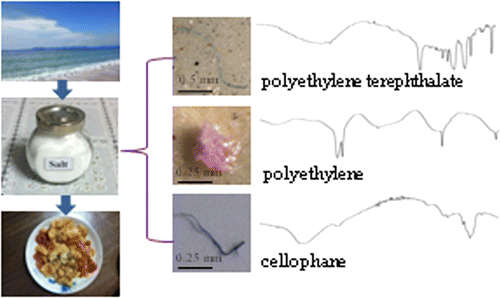Commercial sea salt samples purchased in China contaminated with microplastics

Tiny plastic bits, collectively known as called microplastics, are showing up in bodies of water around the world, and are accumulating in aquatic creatures, including fish and shellfish. Now scientists, after testing a sampling of commercial products in China, have reported for the first time that they also could be contaminating something else we consume from the sea salt. Their study appears in ACS' journal Environmental Science & Technology.
Microplastics are defined as plastic particles smaller than 5 millimeters in size. They come from a variety of sources, including industrial waste, personal care products and plastic litter that degrade in the environment. What this pollution means for aquatic life and people who consume seafood isn't clear, but experts have raised concerns about potential health effects. Some lab tests have shown nano-sized plastic fragments can enter cells and cause tissue damage. With increasing reports on this issue, Huahong Shi and colleagues wanted to see whether microplastics might also be in sea salt. The seasoning is made by evaporating sea water and is now a popular alternative to regular table salt, which comes from underground deposits.
The researchers tested 15 brands of sea salts, lake salts, and rock and well salts from underground deposits purchased at Chinese supermarkets. The sea salts contained the highest concentrations of microplastics from 550 to 681 particles per kilogram. Rock and well salts had the lowest amounts ranging from 7 to 204 particles per kilogram, suggesting these salts from dry deposits likely get contaminated during processing. If adults were to consume sea salt at the recommended nutritional level for the seasoning, they could potentially ingest 1,000 microplastic particles every year from that source. For the sake of comparison, another study has estimated that many Europeans consume about 11,000 of these particles every year by eating contaminated shellfish.
More information: Dongqi Yang et al. Microplastic Pollution in Table Salts from China, Environmental Science & Technology (2015). DOI: 10.1021/acs.est.5b03163
Abstract
Microplastics have been found in seas all over the world. We hypothesize that sea salts might contain microplastics, because they are directly supplied by seawater. To test our hypothesis, we collected 15 brands of sea salts, lake salts, and rock/well salts from supermarkets throughout China. The microplastics content was 550–681 particles/kg in sea salts, 43–364 particles/kg in lake salts, and 7–204 particles/kg in rock/well salts. In sea salts, fragments and fibers were the prevalent types of particles compared with pellets and sheets. Microplastics measuring less than 200 μm represented the majority of the particles, accounting for 55% of the total microplastics, and the most common microplastics were polyethylene terephthalate, followed by polyethylene and cellophane in sea salts. The abundance of microplastics in sea salts was significantly higher than that in lake salts and rock/well salts. This result indicates that sea products, such as sea salts, are contaminated by microplastics. To the best of our knowledge, this is the first report on microplastic pollution in abiotic sea products.
Journal information: Environmental Science & Technology
Provided by American Chemical Society





















